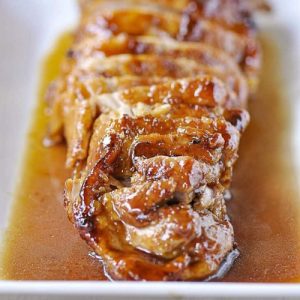
Juicy Maple Glazed Pork Tenderloin
Tender pork tenderloins are coated in a lightly spiced cornstarch mixture, seared for a golden crust, and finished with a rich maple-molasses glaze. Quick to prepare and roast, this dish is high in protein, low in carbs, and perfect for weeknight dinners or meal prep.
Equipment
- 12-inch nonstick skillet
- Rimmed baking sheet (2)
- Measuring cups
- Measuring Spoons
- Paper Towels
- Instant-read thermometer
- Small mixing bowls (2)
- Wooden spoon
Ingredients
- ½ cup pure maple syrup divided
- ¼ cup light molasses
- 1 Tbsp red wine vinegar
- ¼ tsp smoked paprika
- ¼ tsp ground ginger
- ¼ cup cornstarch
- 2 Tbsp sugar
- 1 Tbsp table salt
- 2 tsp ground black pepper
- 3 lb pork tenderloins 2 tenderloins, approx. 1½ lb each
- 2 Tbsp canola oil
Instructions
- Preheat the Oven for Even Cooking: Begin by preheating your oven to 375°F (190°C). Position one oven rack in the upper-middle section and the other in the lower-middle section to ensure even heat distribution. This will allow the pork tenderloins to roast uniformly and develop a perfect crust. Prepare two rimmed baking sheets by lightly greasing them or lining with parchment paper for easy cleanup.
- Prepare the Maple-Molasses Glaze: In a medium-sized bowl or liquid measuring cup, combine ¼ cup of pure maple syrup, ¼ cup light molasses, 1 tablespoon red wine vinegar, ¼ teaspoon smoked paprika, and ¼ teaspoon ground ginger. Whisk these ingredients together until smooth. This glaze mixture will add a sweet, smoky, and slightly tangy flavor that perfectly complements the richness of the pork. Set it aside for later use.
- Make the Seasoned Cornstarch Coating: In a small bowl, whisk together ¼ cup cornstarch, 2 tablespoons sugar, 1 tablespoon salt, and 2 teaspoons ground black pepper. This coating not only enhances flavor but also helps create a lightly crispy crust when seared. Evenly pat the mixture onto a rimmed baking sheet, which will make it easier to coat the pork.
- Coat the Pork Tenderloins: Pat the pork tenderloins dry with paper towels to remove excess moisture—this step is crucial for a good sear. Roll each tenderloin in the cornstarch mixture until fully coated on all sides, ensuring every inch is covered. Shake off any excess cornstarch; too much leftover powder can result in a gummy texture during roasting.
- Sear the Pork Tenderloins: Heat 2 tablespoons canola oil in a 12-inch nonstick skillet over medium-high heat until it shimmers. Carefully place the tenderloins into the hot skillet, leaving at least 1 inch of space between them to allow for even browning. Sear the pork for 5–6 minutes, turning frequently, until all sides are golden brown. The searing step locks in juices and builds a flavorful crust.
- Transfer to the Baking Sheet: Once seared, transfer the tenderloins to a lightly greased baking sheet. This will allow the pork to finish roasting in the oven without sticking.
- Simmer the Glaze on the Stove: Discard any excess fat from the skillet and return it to medium heat. Pour the prepared maple-molasses glaze into the skillet, scraping up any browned bits with a wooden spoon. Simmer the glaze for 1–2 minutes, allowing it to thicken slightly and intensify in flavor. Carefully transfer 1½ tablespoons of the hot glaze into a small bowl and set aside; this will be used later for finishing touches.
- Apply the First Glaze Layer: Brush each tenderloin generously with the remaining glaze, using approximately 1 tablespoon per tenderloin. Ensure the glaze coats the top and sides to create a rich, flavorful layer. Roast the pork in the preheated oven for 15–20 minutes, or until an instant-read thermometer inserted into the thickest part reads 130°F (54°C).
- Apply the Second Glaze Layer: Remove the tenderloins briefly from the oven and brush each with another tablespoon of the glaze. Return them to the oven for an additional 4–6 minutes, or until the internal temperature reaches 135–140°F (57–60°C). This step ensures the pork is juicy, tender, and perfectly cooked while developing a glossy, caramelized finish.
- Rest the Pork Tenderloins: Remove the baking sheet from the oven and brush the tenderloins with the remaining glaze. Allow the pork to rest for 10 minutes; resting allows the juices to redistribute throughout the meat, ensuring every slice is moist and flavorful.
- Finish with Extra Maple Glaze: While the pork rests, stir the remaining ¼ cup maple syrup into the reserved 1½ tablespoons of glaze. If the glaze has thickened, warm it gently over low heat to return it to a brushable consistency. Brush this final glaze over the pork tenderloins just before slicing for a sweet, glossy finish.
- Slice and Serve: Using a sharp knife, slice the tenderloins into ¼- to ½-inch thick slices. Arrange on a serving platter and drizzle with any remaining glaze. Serve immediately with your favorite sides, such as roasted vegetables, mashed potatoes, or a fresh salad. The result is a tender, juicy, and flavorful pork tenderloin with a perfectly balanced sweet and smoky maple glaze.
Notes
- Always pat the pork dry before coating with cornstarch to achieve a golden, crisp sear.
- Use pure maple syrup rather than imitation to ensure authentic flavor.
- Monitor internal temperature carefully using an instant-read thermometer; removing the pork slightly underdone allows for perfect juiciness after resting.
- If one tenderloin is smaller than the other, remove it earlier to prevent overcooking.
- Brush the glaze in multiple layers for a glossy, caramelized finish.
- Cover the baking sheet with foil for easier cleanup, as the glaze can caramelize and stick.